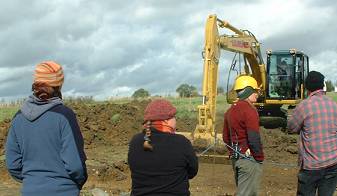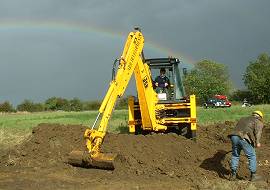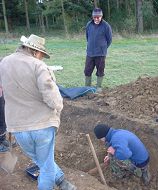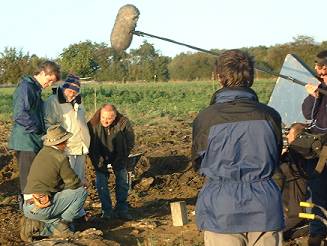
Time Team strikes again

| Grafton Regis Time Team strikes again |
| Home | Events & Notices | Recent Discoveries | Publications | Links | How To Join | Contact Us |
During the first week of October 2004, Time Team filmed the final episode of their 12th series at a site just outside Grafton Regis (and technically just inside Buckinghamshire). When, last year, I worked as a "local digger" on an episode filmed at The Prebendal Manor House in Nassington, I considered it would be my one an only involvement with the programme. However my name must have been left on their database and perhaps they were short staffed at the last moment, because on October 1st they invited me back to reprise my role as a clapped out, arthritic, trowel monkey. Having been stuck in front of a computer screen for several months and mindful of the very fine lunches that were on offer, I accepted with indecent haste.
The site was on land farmed by the late Oliver Ransom and first excavated by the Wolverton and District Archaeological Society in 1980. Since 1998 it has been the home of a training excavation run by the Gordon's Lodge Archaeological Field School which had produced evidence of medieval settlement and metal working, while aerial survey has revealed a large enclosure that was thought to be either medieval or prehistoric. The Domesday entry for the area described amongst other things, an unusually large number of pigs, perhaps reflecting its association with woodland.
Day One
 |
| The main site |
When viewed on the first day, the main part of the site appeared to be a large abandoned excavation that was now covered in thistles. As with the episode of Time Team filmed at Nassington, the "local diggers" spent, the first hours sitting around doing nothing. However by mid morning we were all called out for a spot of troweling.
 |
| Northamptonshire Archaeology
diggers, Sharon Clough and Jennifer Jackson, watch while more clay is exposed for them to trowel. |
Unfortunately the site is on clay which all excavators agree, is the worst soil to dig on. It is unyielding when dry and intractable when wet. Troweling it is torture and the edges of archaeological features are at best indistinct if not actually invisible. To begin with we concentrated on an area within which were the remains of a structure, thought to be part of a manorial site. It rapidly became clear that the structural remains were those of a small building with unmortared walls that was soon being described as a hovel rather than a manor. The highlight of the day was without doubt a lunch of duck legs in a citrus glaze and all the trimmings.
Troweling resumed around the original building while new trenches were cut elsewhere in the surrounding area, including one across the large enclosure. After lunch (lasagne), I moved into a new trench where two sections of the ditch were being cut. This revealed a very fine land drain, which was picked up in the second cut along with another larger and more recent pipe. The possibilities of a land drain typology began to suggest themselves.
| Digging continues... | A triumph for geophysics! | ||
 |  | ||
| But is this nature's
way of suggesting that we are looking in the wrong place? | The first of two
land drains located in the same trench. |
I moved to a new trench
and was told to mattock an area of what looked to me to be natural subsoil. It
seemed as though we had been assigned the role of producing a repetitive metallic
thud to counterpoint the clinking trowels that were being filmed at the other
end of the trench. Obviously, televised archaeology requires a certain amount
staging but some of this was a little questionable. When the Northamptonshire
Archaeology diggers turned up on the first day they were wearing fluorescent coats
as is required by Health and Safety regulations on sites where heavy machinery
is operating. They were immediately told to remove them by a member of the production
staff because the coats made them too visible (rather the point you might have
thought).
The final afternoon was preceded by a vast plate of chicken
in a tangy sauce followed by fresh fruit salad. Then I was given a substantial
post hole to dig that produced some respectable quantities of medieval pottery.
Finally it emerged that the site was being interpreted as a specialist pig farm
on the basis of the large numbers of pigs mentioned in the Domesday Book. From
the Time Team excavation there had been some finds of bones but these were predominantly
cattle and sheep. It was proposed that the putative pigs were raised and possible
slaughtered on the site but were then either driven to market or taken there "on
the bone". Thus no trace of them was actually left on the site. This may
seem like a rather rickety ladder of inference, even for Time Team, however I
recall a recent hypothesis, similarly unencumbered by evidence, being proposed
by Oxford Archaeology to posit Iron Age horse rearing in the upper Thames valley.
 |
| A hypothesis of disappearing
pigs eventually explains the site |